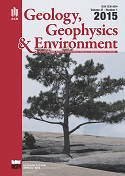Influence of resolution in spatial and time for numerical modeling of levees
DOI:
https://doi.org/10.7494/geol.2015.41.1.71Keywords:
numerical modeling, levee, stabilityAbstract
Stability of geotechnical constructions, such as levees, is one of the most important issue for urban areas. The precise prediction of levees destruction during the flood can not only save human lives and properties, but also protect the natural environment. Water level changes and its influence on the stability of levee was conducted by 2D and 3D numerical modeling. The results of two dimensional numerical modeling shows that it can be regarded as a powerful and sufficient tool to estimate the stability of levees. The optimal size of grid and time step can make this calculation more efficient.Downloads
References
Project ISMOP (www.ismop.edu.pl)
Itasca Consulting Group, Inc., 2011. FLAC Fast Langrangian Analysis of Continua. User Manual. Minneapolis, Minnesota
Bukowska-Belniak, B, Krawiec, K., 2014. Influence of the shape and density of grid computing to the accuracy of the numerical simulation of the flood embankments model. 14th GeoConference on Informatics, Geoinformatics and Remote Sensing, pp.643-649, DOI:10.5593/sgem2014B21
Pięta, A., Dwornik, M., 2014. Analysis of boundary conditions offset for the accuracy of the numerical modeling of the levees.14th GeoConference on Informatics, Geoinformatics and Remote Sensing, pp.457-464, DOI:10.5593/sgem2014B21
Krzhizhanovskaya, V.V., Shirshov, G., Melnikova, N., Belleman, R.G., Rusadi, F., Broekhuijsen, B., Gouldby, B., Lhomme, J., Balis, B., Bubak, M., et al., 2011. Flood early warning system: design, implementation and computational modules. Procedia Computer Science 4, 106–115
Downloads
Published
Issue
Section
License
Authors have full copyright and property rights to their work. Their copyrights to store the work, duplicate it in printing (as well as in the form of a digital CD recording), to make it available in the digital form, on the Internet and putting into circulation multiplied copies of the work worldwide are unlimited.
The content of the journal is freely available according to the Creative Commons License Attribution 4.0 International (CC BY 4.0)










